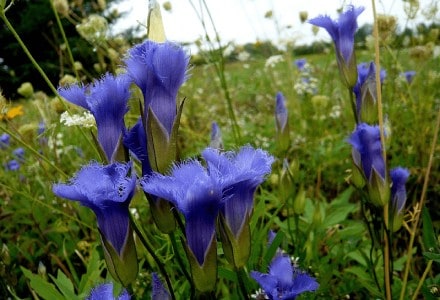
Photographer: Seabamirum
CC License: https://bit.ly/1ryPA8o
Fringed Gentian Facts
- Perhaps most notably of all, the distinctive term of Fringed Gentian serves as the most frequently used of the common names for a gorgeous variety of Angiosperm. The dazzling wonder also has two alternate common names, though.
- These consist of such equally descriptive terms as the blue gentian, and the greater blue gentian. The majority of botanists, though, typically know the gorgeous species best by its difficult to pronounce scientific name. That’s the term Gentianopsis crinita.
- This stunning marvel of Nature also remains quite famous. This further holds true among a respectably large percentage of professional researchers. That very impressive perspective also holds true due to an enviable statistic.
- That’s the fact that, in the opinion of many botanists, this species easily ranks as one of the most interesting flowers in the world. This greatly elevated position occurs due to some of the comparatively unique characteristics it demonstrates.
- For one, the extremely sensitive and comparatively delicate blooms of the Fringed Gentian are highly specialized. That’s because they only open on bright, sunny days. These flowers also typically remain closed if bright sunshine remains absent.
- The magnificent species also has a short lifespan, with most plants living for less than two years. Fortunately, though, this visually breathtaking Angiosperm appears to still be relatively prevalent throughout the entirety of its tiny native range.
- The IUCN, therefore, currently lists it as Least Concern, on its Red List on its Red List of Threatened Species. It could nonetheless potentially be at some risk due to several factors. These include habitat loss, and of course, the effects of climate change.
Related Articles
Snowdrop Orpheus Flower Maguire Daisy
Fringed Gentian Physical Description
To the surprise of many people who learn of it, the Fringed Gentian also merits respect for factors other than just its great beauty. That statement holds true due to the surprising fact that this work of Nature also achieves a great physical size, compared to related species.
In point of fact, this remarkable variety of Angiosperm attains an astounding average height measuring approximately 3.3 ft (1 m). Some specimens of the species, however, may remain shorter, depending on variable environmental conditions.
Regardless of height, though, its most notable feature is the stunning blooms it produces. That’s due to the fringed structure of the petals. This serves as the source of the common name for the plant, which also evolved as both a perennial, and herbaceous in nature.
Each of the stunning flowers of the Fringed Gentian further appear at the end of a long, tapering stalk. In color, this typically displays a brilliantly iridescent blue. Its delicate blossoms also produce a sweet, delicate scent, for which it remains well known.
Each of these stalks attain a relatively respectable length. More precisely, these frequently grow to a length of as much as 8 in (20 cm). The leaves of the marvel of Nature also grow in abundance. This impressive foliage averages about 2 in (5 cm) in length.
- Kingdom: Plantae
- Phylum: Tracheophytes
- Class: Angiosperms
- Order: Gentianales
- Family: Gentianaceae
- Genus: Gentianopsis
- Species: G. crinita
Fringed Gentian Distribution, Habitat, and Ecology
Quite unfortunately, and despite being listed as Least Concern, the beautiful Fringed Gentian only inhabits an extremely tiny portion of the world. In point of fact, the Angiosperm only lives in the wild in eastern parts of the United States, and eastern Canada.
Within that area, however, it typically appears from the southern Appalachian Mountains north into New England and west to Manitoba and Iowa. Scattered individuals, however, can occasionally be seen as far south as the mountains of the state of Georgia.
Despite that range, it’s not as prevalent as one might think. That’s because it only grows in widely scattered pockets, with its total population remaining low. But, its astonishing beauty has led to the species being transplanted in small numbers in other regions.
This includes, to the great surprise of many of those who learn of it, the majestic Yellowstone National Park. Nevertheless, in the various regions it does appear in, the Fringed Gentian, despite its otherwise fragile nature, displays a highly remarkable tendency.
That’s because it usually develops in thinly wooded sections, various wet meadows, and the banks of streams and brooks. Areas it grows in include damp sand prairies, sandy sloughs and swales, sandy pannes along Lake Michigan, near ravines, and ditches.
Remarkably, this awesome species of Angiosperm continues to hold its own in some areas. This largely occurs due to its natural resourcefulness, in being able to live where few other plants can. Nature therefore provided the delicate beauty with an advantage.
Fortunately, when it does make an appearance, few animals find its foliage palatable, reducing its vulnerability. For reasons that presently remain unknown, its flowers generally attract bumblebees, instead of honey bees. The reason, though, is undetermined.
Species Sharing Its Range
Opossum Carolina Silverbell Luna Moth
Check out our other articles on 4 Stupendous Stick Insects, Barreleye Fish, Jeju Island, Dall’s Porpoise, Lord Howe Island Stick Insect, Flatback Sea Turtle, Vietnamese Mossy Frog

